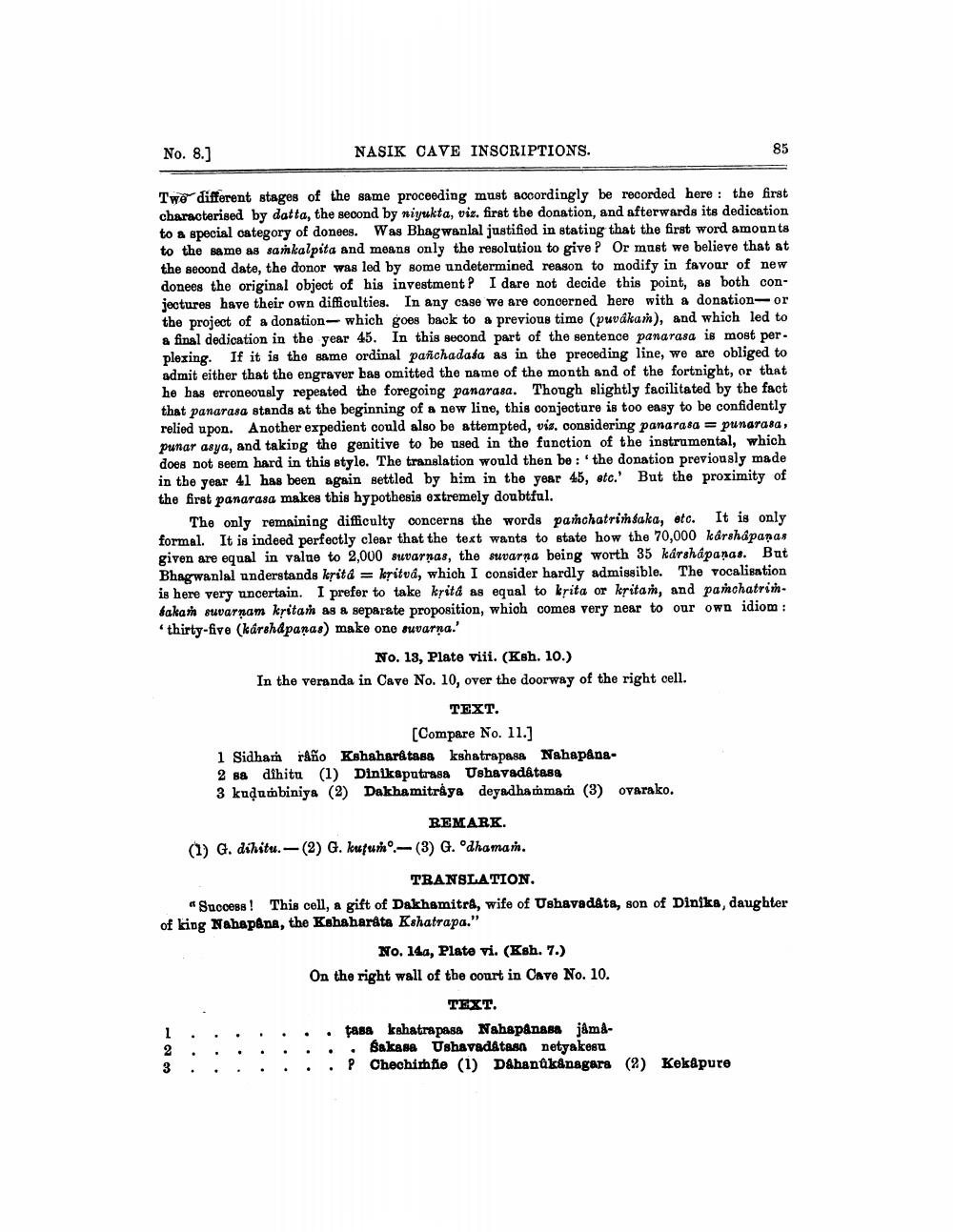________________
No. 8.]
NASIK CAVE INSCRIPTIONS.
85
Two different stages of the same proceeding must accordingly be recorded here : the first characterised by datta, the second by niyukta, viz. first the donation, and afterwards its dedication to a special category of donees. Was Bhagwanlal justified in stating that the first word amounts to the same as sankalpita and means only the resolution to give ? Or most we believe that at the second date, the donor was led by some undetermined reason to modify in favour of new donees the original object of his investment? I dare not decide this point, as both conjectures have their own difficulties. In any case we are concerned here with a donation or the project of a donation-which goes back to a previous time (puvakan), and which led to a final dedication in the year 45. In this second part of the sentence panarasa is most perplexing. If it is the same ordinal pañchadasa as in the preceding line, we are obliged to admit either that the engraver bas omitted the name of the month and of the fortnight, or that he has erroneously repeated the foregoing panarasa. Though slightly facilitated by the fact that panarasa stands at the beginning of a new line, this conjecture is too easy to be confidently relied upon. Another expedient could also be attempted, vis, considering panarasa = punarasa, punar asya, and taking the genitive to be used in the function of the instrumental, which does not seem hard in this style. The translation would then be : the donation previously made in the year 41 has been again settled by him in the year 45, etc. But the proximity of the first panarasa makes this hypothesis extremely doubtful.
The only remaining difficulty concerns the words panchatrimsaka, etc. It is only formal. It is indeed perfectly clear that the text wants to state how the 70,000 kárshápanas given are equal in value to 2,000 suvarnas, the suvarna being worth 35 kárshápanas. But Bhagwanlal understands krita = ksitva, which I consider hardly admissible. The vocalisation is here very uncertain. I prefer to take krità as equal to ksita or ksitan, and panchatrintakan suvarnam kritar as a separate proposition, which comes very near to our own idiom : thirty-five (kárshápaņas) make one suvarna.'
No. 13, Plate viii. (Ksh. 10.) In the veranda in Cave No. 10, over the doorway of the right cell.
TEXT.
[Compare No. 11.) 1 Sidhar raño Kshahardtass kshatrapasa Nahapana2 88 dihitu (1) Dinikaputrasa Ushavadatasa 3 kudumbiniya (2) Dakhamitrảya deyadhanman (3) ovarako.
REMARK. (1) G. dihitu. -(2) G. kufun-(3) G. odhaman.
TRANSLATION. « Success! This cell, a gift of Dakhamitra, wife of Ushavad&ta, son of Dinika, daughter of king Nahapana, the Kshaharata Kshatrapa."
No. 14a, Plate vi. (Ksh. 7.) On the right wall of the court in Onve No. 10.
TEXT. 1 . .
kshatra pasa Nahapanasa jama2 . . . . . . . . Bakase UshavadAtasn netyskesu 3 . . . . . . . P Chechimie (1) Dahanukanagara (2) Kekapure




